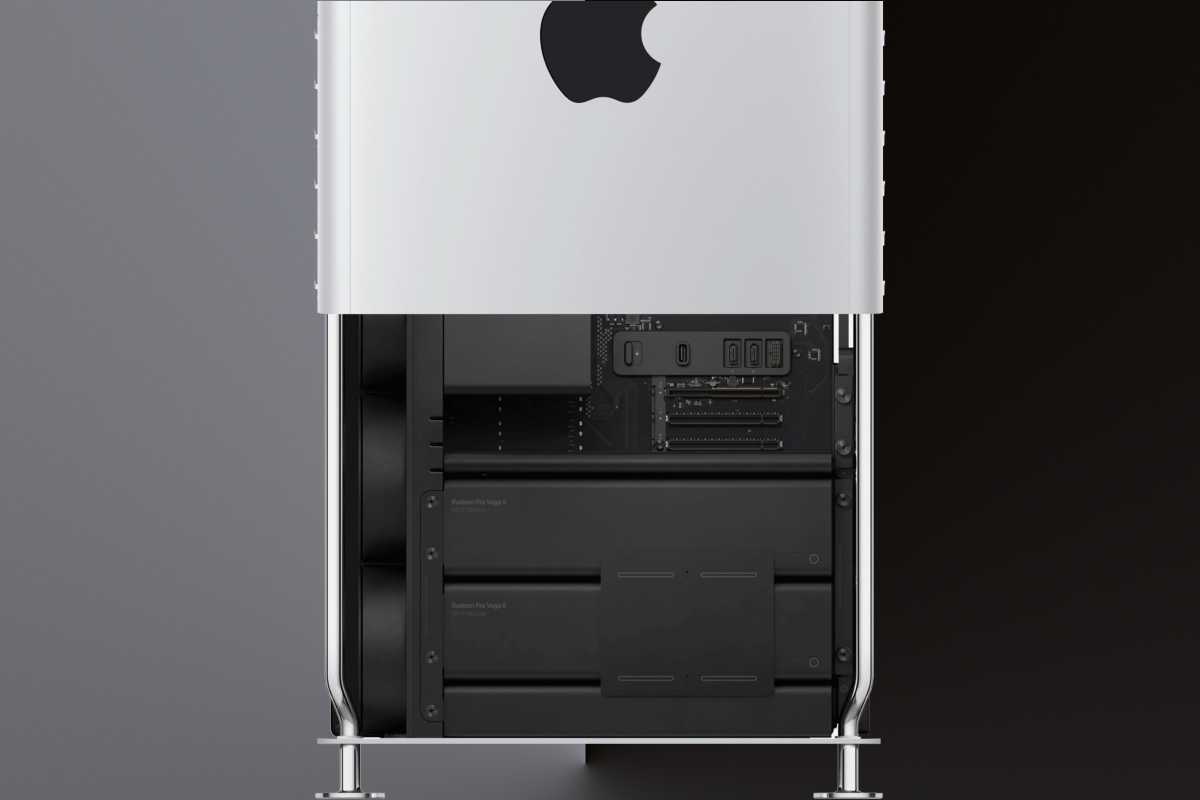Back when Apple announced its transition from Intel processors in June 2020, it made a few promises that weren’t delivered. Most notably, he said the transition would be complete “in about two years,” either four months or eight months late, depending on when you start counting.
And in addition to committing to “continue to support and release new versions of macOS for Intel-based Macs for years to come,” which it does, Apple also said it “has new Intel-based Macs in development”. Although we did get a new 27-inch iMac with 10th Gen Intel chips later this summer, suffice to say we haven’t seen any new Intel Macs, exciting or not, since the first M1 Macs rolled out. And with only one Intel Mac remaining in Apple’s lineup, it seems only a matter of time before the Mac Pro gets its Apple silicon makeover.
In fact, about a year ago, John Ternus teased the existence of such a machine, saying there was “only one product to do” in the transition, “but that’s for another day”. But as time passes, maybe everyone would be happier if that day didn’t come right away.
The central problem
The latest Mac Pro rumors are far from intriguing, as the unique architecture of the M2 chip would force Apple to redesign many of the Mac Pro’s unique features, including user-upgradable RAM and graphics. . And the M2 Extreme chip with 48 CPU cores and 152 graphics cores is unlikely to make an appearance, with Apple opting instead for a slightly overclocked M2 Ultra with a 24-core CPU and 76-core GPU.

The Mac Studio costs thousands less than the Mac Pro but is just as fast.
Foundry
It’s pretty fast, sure, but compared to the current M1 Ultra Mac Studio, it’s not worth the $17,000 starting price for the top-end Intel Mac Pro with a 28-core Intel Xeon W processor. When the Mac Pro launched in 2019, its closest competitor was the iMac Pro’s 18-core Intel Xeon W, which paled in benchmark comparisons (13,453 vs. 26,604 in Geekbench’s multi-core tests). Granted, the Mac Pro costs about $10,000 more than the iMac Pro, but that huge price gap only underscored how much more speed you get.
According to the latest reports, this will not be the case with the new Mac Pro. While it’s obviously faster than the current high-end Mac Pro and high-end Mac Studio, especially if Apple doesn’t update the Mac Studio to an M2 chip, the gap won’t be as big. big as with the previous Mac Pro. Geekbench benchmarks for the M1 Ultra top out at around 24,000, so we can assume the M2 Ultra would hit around 30,000 or so with the same 20-25% increase. That’s more than the current 28-core Intel Xeon W processor (26,604), but not by far.
With so much power, even at the lowest end of its Mac chips, Apple has pa inted itself into a tight corner with the Mac Pro. Maybe Apple can significantly reduce the price by using Apple silicon, but that’s not as important as performance for its target audience. Buyers expect the Mac Pro to be “a system created to allow a wide range of professionals to push the limits of what’s possible,” but with meager performance upgrades and limited expansion, buyers won’t won’t get the same machine that pushes the boundaries.
Intel inside (again)
Even if it were to bring a huge speed boost, Mac Pro buyers might be hesitant to upgrade to Apple silicon anyway. The Mac Pro is the type of machine that people buy to meet a very specific need, and those needs may be related to existing peripherals and applications that don’t work as well (or at all) on Apple Macs in silicon. And as one reader pointed out this week, some Mac Pro users also need to run Windows natively, which isn’t possible under Apple silicon without virtualization.

If Apple puts Intel in the next Mac Pro, it will make a lot of people happy.
Apple
For those people – and I suspect there are many – an upgraded Intel model is probably preferable to an M2 Ultra-based model, especially if Apple were to use one of the latest Intel Xeon W-3400 or Xeon chips. W-2400. Last week, Intel unveiled its latest workstation-class chips with up to 56 cores and 112 threads. These are excellent specs that are certain to match or beat the rumored M2 Ultra.
As my colleague Jason Cross points out, Apple would be more likely to use the W-2400 chips which cap out at 24 cores due to thermals. (The highest-end Intel processor in the Mac Pro has a thermal design power of 205 watts. The W-2400 series ranges from 120 W to 225 W while the W-3400 ranges from 270 W to 350 W.) Apple prioritizes power efficiency with its M-series chips, so it would be unlikely to use a chip with such high power consumption.
But even the low-end chip would still be a great upgrade over the current Mac Pro, while giving users the expandability and aftermarket upgrades they need. I don’t think potential buyers would be mad at a new Intel machine that preserves the Mac Pro’s mission while delivering a massive speed boost over the 2019 model Apple is still selling. Intel would allow users to easily upgrade their current configuration, retain the upgrade capability they need, and give Apple a bit more time to build a suitable Apple silicon model.
And if any of those buyers really want an Apple silicon machine, they can always buy a MacBook Pro to go along with it.








.jpg/BROK/thumbnail/1200x630/call-of-duty-modern-warfare-2-warzone-2-season-2-(23).jpg)